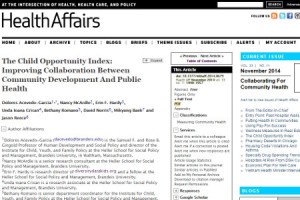 Improving neighborhood environments for children through community development and other interventions may help improve children’s health and reduce inequities in health. A first step is to develop a population-level surveillance system of children’s neighborhood environments.
Improving neighborhood environments for children through community development and other interventions may help improve children’s health and reduce inequities in health. A first step is to develop a population-level surveillance system of children’s neighborhood environments.
This article, authored by Dolores Acevedo-Garcia and colleagues for the November 2014 issue of Health Affairs, presents the newly developed Child Opportunity Index for the 100 largest US metropolitan areas. The index examines the extent of racial/ethnic inequity in the distribution of children across levels of neighborhood opportunity, revealing the following key findings:
The Child Opportunity Index provides perspectives on child opportunity at the neighborhood and regional levels and can inform place-based community development interventions and non-place-based interventions that address inequities across a region. The index can also be used to meet new community data reporting requirements under the Affordable Care Act.